
Chervona Ukraina was an Admiral Nakhimov-class light cruiser of the Soviet Navy assigned to the Black Sea Fleet. During World War II, she supported Soviet forces during the Sieges of Odessa and Sevastopol before being sunk at Sevastopol on 12 November 1941 by German aircraft. She was raised in 1947 and was used as a training hulk before becoming a target ship in 1950.
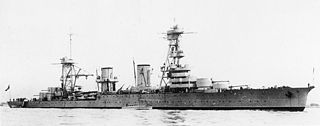
Krasny Kavkaz was a cruiser of the Soviet Navy that began construction during World War I, but was still incomplete during the Russian Revolution. Her design was heavily modified by the Soviets and she was completed in 1932. During World War II she supported Soviet troops during the siege of Odessa, siege of Sevastopol, and the Kerch–Feodosiya operation in the winter of 1941–42. She was awarded the Guards title on 3 April 1942. She was reclassified as a training ship in May 1947 before being expended as a target in 1952.

The Svetlana-class cruiser was the first class of light cruisers built for the Imperial Russian Navy (IRN) during the 1910s. Construction was interrupted by World War I, the Russian Revolution and the Russian Civil War. Only Svetlana of the quartet was completed by the Soviet Union as a cruiser, two were converted to oil tankers, and the remaining ship was scrapped without being completed.
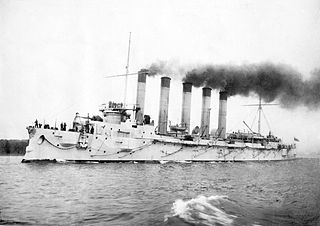
Askold was a protected cruiser built for the Imperial Russian Navy. She was named after the legendary Varangian Askold. Her thin, narrow hull and maximum speed of 23.8 knots (44.1 km/h) were considered impressive for the time.

HMS Suffolk was one of 10 Monmouth-class armoured cruisers built for the Royal Navy in the first decade of the 20th century. Upon completion she was assigned to the 3rd Cruiser Squadron of the Mediterranean Fleet and was then assigned to the 5th Cruiser Squadron in the Mediterranean in 1909 after a lengthy refit. She returned home for another refit in 1912 and became the flagship of the 4th Cruiser Squadron on the North America and West Indies Station in 1913.

SMS Stettin was a Königsberg-class light cruiser of the Kaiserliche Marine. She had three sister ships: Königsberg, Nürnberg, and Stuttgart. Laid down at AG Vulcan Stettin shipyard in 1906, Stettin was launched in March 1907 and commissioned into the High Seas Fleet seven months later in October. Like her sisters, Stettin was armed with a main battery of ten 10.5 cm (4.1 in) guns and a pair of 45 cm (18 in) torpedo tubes, and was capable of a top speed in excess of 25 knots.

HMS Donegal was one of 10 Monmouth-class armoured cruisers built for the Royal Navy in the first decade of the 20th century. She was initially assigned to the 1st Cruiser Squadron upon completion in 1903 and ran aground en route to the China Station in 1906. She was briefly placed in reserve after repairs before she was assigned to the Home Fleet in 1907. She joined the 4th Cruiser Squadron on the North America and West Indies Station in 1909 before returning home for an assignment with the Training Squadron in 1912. Donegal was reduced to reserve before World War I began in August 1914 as part of the Third Fleet
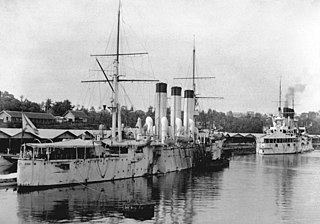
Diana was the second of three Pallada-class protected cruisers built for the Imperial Russian Navy. The cruiser served during the Russo-Japanese War and took part in the Battle of the Yellow Sea on 10 August 1904. Later, she served as part of the Russian Baltic Fleet during World War I.

HMS Centaur was a C-class light cruiser of the Royal Navy that served in the First World War and the Russian Civil War. She was the name ship of the Centaur group of the C-class of cruisers.

HMS Lowestoft was a Town-class light cruiser built for the Royal Navy in the 1910s. She was a member of the Birmingham sub-class of the Town class. She survived World War I and was sold for scrap in 1931.
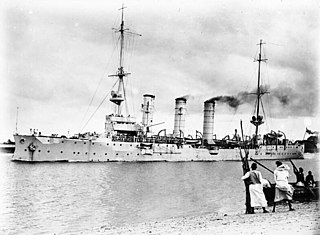
The Königsberg class was a group of four light cruisers built for the German Imperial Navy. The class comprised four vessels: SMS Königsberg, the lead ship, SMS Nürnberg, SMS Stuttgart, and SMS Stettin. The ships were an improvement on the preceding Bremen class, being slightly larger and faster, and mounting the same armament of ten 10.5 cm SK L/40 guns and two 45 cm (17.7 in) torpedo tubes.

Oleg was the 4th and final Bogatyr-class protected cruiser built for the Imperial Russian Navy.

Komintern was a Soviet light cruiser originally named Pamiat' Merkuria, a Bogatyr-class protected cruiser built for the Imperial Russian Navy. She saw service during World War I in the Black Sea and survived the Russian Civil War, although heavily damaged. She was repaired by the Soviet Navy and put into service as a training ship. In 1941 she was reclassified as a minelayer and provided naval gunfire support and transported troops during the sieges of Odessa, Sevastopol, and the Kerch–Feodosiya operation in the winter of 1941–1942. She was damaged beyond repair at Poti by a German air attack on 16 July 1942. Afterwards she was disarmed and hulked. At some point she was towed to the mouth of the Khobi river and sunk there as a breakwater on 10 October 1942.
SMS Stuttgart was a Königsberg-class light cruiser of the Kaiserliche Marine, named after the city of Stuttgart. She had three sister ships: Königsberg, Nürnberg, and Stettin. Stuttgart was laid down at the Imperial Dockyard in Danzig in 1905, launched in September 1906, and commissioned in February 1908. Like her sisters, Stettin was armed with a main battery of ten 10.5 cm (4.1 in) guns and a pair of 45 cm (18 in) torpedo tubes, and was capable of a top speed in excess of 25 knots.
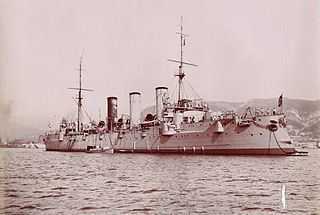
The cruiserBogatyr, launched 1901, was the lead ship of the Bogatyr class of four protected cruisers built between 1898 and 1907 for the Imperial Russian Navy.

Bayan was the third of the four Bayan-class armoured cruisers built for the Imperial Russian Navy in the early 1900s. The ship was assigned to the Baltic Fleet. She was modified to lay mines shortly after World War I began. Bayan laid mines herself and provided cover for other ships laying minefields. The ship fought several inconclusive battles with German ships during the war, including the Battle of Åland Islands in mid-1915. She also participated in the Battle of Moon Sound during the German invasion of the Estonian islands in late 1917, where she was damaged. Bayan was decommissioned in 1918 and sold for scrap in 1922.

Admiral Makarov was the second of the four Bayan-class armoured cruisers built for the Imperial Russian Navy during the mid-1900s. While initially assigned to the Baltic Fleet, the ship was detached to the Mediterranean several times before the start of World War I in 1914. She was modified to lay mines shortly after the war began. Admiral Makarov laid mines herself during the war and provided cover for other ships laying minefields. The ship fought several inconclusive battles with German ships during the war, including the Battle of Åland Islands in mid–1915. She also defended Moon Sound during the German invasion of the Estonian islands in late 1917. Admiral Makarov was decommissioned in 1918 and sold for scrap in 1922.

The Admiral Nakhimov-class cruisers were a group of four light cruisers built for the Imperial Russian Navy just before World War I began in 1914. Construction was interrupted by the Russian Revolution and only two of the ships were eventually completed well after the end of the Russian Civil War by the Soviets. Chervona Ukraina was the first ship completed and was built to essentially the original design. Krasnyi Kavkaz was much modified and completed five years after Chervona Ukraina. Both ships participated in the Sieges of Odessa and Sevastopol after the Germans invaded Russia in June 1941. They ferried troops into the cities, evacuated wounded and bombarded the besieging German troops. Chervona Ukraina was bombed and sunk by dive bombers in November during one of these missions and Krasny Kavkaz was badly damaged by the same type of aircraft in January 1942. After her lengthy repairs were completed, the ship transported reinforcements to cities on the Black Sea coast during the Battle of the Caucasus. She was reclassified as a training ship in 1947 before she was sunk as a target in 1956. Chervona Ukraina was salvaged in 1947 and then became a hulked. She became a target ship in 1950.



















